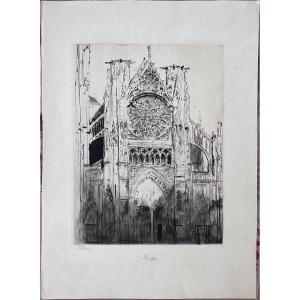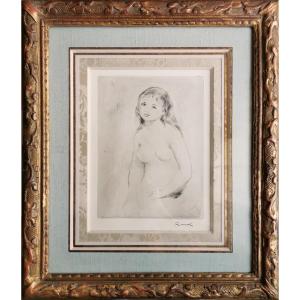- slightly darkened, minimal light-staining, very occasional foxing, remains of an old mounting on the reverse
- Impressionist Conciseness -
This print was made as a supplement to the ninth volume of the Illustrierte Monatsschrift für Kunst und Kunstgewerbe, published by Bruno Cassirer in 1911. Max Slevogt had lived in Berlin since 1901 and was now one of the city's most renowned artists, along with Max Liebermann and Lovis Corinth. The self-portrait, published in Cassirer's journal as an example of contemporary art, is also a programmatic representation of his art. Slevogt is seated on a chair in the middle of his studio, his legs extending beyond the edge of the picture, so that we seem to be approaching him. With a slightly narrowed gaze, the artist looks at us and draws our portrait directly onto the plate. Typical of Slevogt's portraiture, the sitter's face is slightly blurred and yet has a distinct feature. With his artistic eye, he is able to render the face directly on the plate with "impressionistic conciseness" without any preliminary drawing. Slevogt demonstrates his artistic virtuosity by using the plate like a sketchbook.
About the artist
From 1884 to 1889 Max Slevogt studied at the Munich Art Academy and then at the Académie Julian in Paris. In 1890 he went on a study trip to Italy with Robert Breyer. Afterwards he lived in Munich as a freelance artist. In 1892 he was a founding member of the 'Freie Vereinigung der XXIV', which emerged from the Munich Secession. Slevogt published caricatures in 'Simplicissimus' and 'Jugend'. Inspired by his visit to the Rembrandt exhibition in Amsterdam in 1898, Slevogt created his scandalous painting 'Danae'. In 1900, Slevogt returned to Paris for the World's Fair, where he participated as an artist and discovered the work of Édouard Manet. In 1901, Slevogt moved to Berlin with Lovis Corinth and joined the Berlin Secession. He also began to produce graphic series and extensive book illustrations for the gallery owners and publishers Paul and Bruno Cassirer. His artistic success in Berlin enabled him to buy his in-laws' estate in Neukastel in 1914, which served as his retreat from then on. In 1914 he went to war as a painter at the front, which shook him to the core. That same year, Slevogt traveled to Egypt, where he produced 29 oil paintings. In 1917, Slevogt became director of the master studio for painting at the Berlin Academy, and in 1922 he was made an honorary member of the Munich Academy. In addition to his work as a painter and sought-after portraitist, Slevogt designed stage sets for the production of Mozart's "Don Giovanni" at the Dresden State Opera in 1924. On his 60th birthday in 1928, the Prussian Academy of Arts honored Slevogt with a large solo exhibition.


































 Le Magazine de PROANTIC
Le Magazine de PROANTIC TRÉSORS Magazine
TRÉSORS Magazine Rivista Artiquariato
Rivista Artiquariato